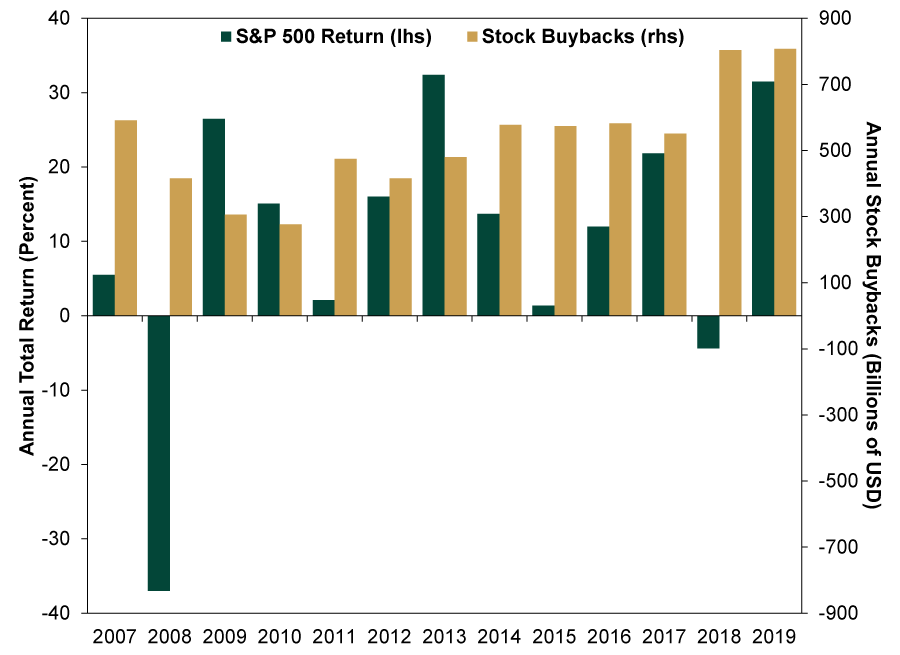Personal Wealth Management / Market Analysis
Why the Next Bull Market Doesn't Hinge on Buybacks
Stock buybacks don’t drive returns, contrary to popular belief.
With the economy ground to a halt and earnings season just around the corner, companies are battening down the hatches. Several have canceled dividends and planned stock buybacks in recent weeks, leaving headlines globally asking: Where will a recovery come from if companies aren’t buying their own stock? Conventional wisdom correlates rising stock buybacks with markets’ rise during the bull market that ran from March 2009 to late February, flagging them as stocks’ main source of demand. Without them, many fear there won’t be enough buyers to cement a recovery and eventually return stocks to new highs. In our view, this misreads buybacks’ market impact. They weren’t the last bull’s driving force, and the next bull can get underway with or without them.
One extreme analysis, based on the Fed’s quarterly Flow of Funds reports, argues buybacks were the sole source of net positive demand during the last bull. As a Wall Street Journal summary explained: “Since the beginning of 2009, [the analyst] estimates, buybacks have added a net $4 trillion to the stock market. Contributions from all other sources—including exchange-traded funds, foreign buyers, insurers, mutual funds, broker dealers, pensions, hedge funds and households—netted out to roughly zero, he concluded, based on the Federal Reserve’s quarterly flow of funds reports.”[i] In our view, some simple math is all it takes to poke holes into this line of reasoning. At the end of 2008, the S&P 500’s market cap was about $7.85 trillion.[ii] When 2019 ended, it was $26.76 trillion.[iii] If the index’s market value rose by nearly $20 trillion, but corporations contributed only $4 trillion, then clearly other forces must be pushing up prices.
Exhibit 1 pokes even more holes, overlaying annual executed S&P 500 buybacks and annual S&P 500 returns. As you will see, 2018 had the second-highest dollar volume of buybacks. Stocks fell that year. In 2009 and 2010, when buybacks were at their lowest, the S&P 500 jumped 26.5% and 15.1%, respectively (including 2009’s 62.1% jump from the bear’s March 9 low through yearend).[iv] In the index’s best year of the last decade, 2013, buybacks were middling.
Exhibit 1: S&P 500 Buybacks and Returns
Source: Compustat North America and FactSet, as of 4/7/2020. S&P 500 annual total returns and annual stock buybacks, 2007 – 2019.
We think there are some conceptual reasons that this shouldn’t surprise. Namely, the stock market is an auction marketplace. It isn’t the number or nature of buyers that matters, but their willingness to pay more for a slice of a company’s future earnings. In that marketplace, there is also mathematically no such thing as money pouring in. Every transaction has two sides—buyer and seller. It isn’t money pouring into a company, but a transfer from the buyer to the seller. Money in, money out. Therefore, it isn’t a huge shock that all the demand sources listed above netted out to zero.
What stocks need in a new bull market isn’t new buyers, corporate or otherwise—the key ingredient is buyers with enough optimism and guts to pay a bit more for future earnings than the last person did. The money could come from cash on hand. Or they could sell bonds. Or they could sell one category of stocks and buy another. The permutations aren’t endless, but there are many.
Buybacks do have an influence, but it is on the supply side, not the demand side. When companies buy their own shares, they basically retire them, shrinking stock supply. At the simplest level, supply and demand drive stock prices, so falling supply is a net positive. Yet even here, we wouldn’t overstate buybacks’ impact. A significant chunk of buyback activity serves to offset new shares issued as part of stock-based compensation packages, which many companies use to give employees—and especially executives—more skin in the same and defer executive compensation. If companies issued these shares without buying back stock in the open market, it would increase their stock supply and dilute existing shareholders, running counter to their obligations to act in shareholders’ best interest. That would also be a disservice to the many frontline employees who receive company stock (particularly in their employer retirement accounts). In other words, buybacks are more about keeping supply in check than artificially pumping prices.
Lastly, some have tried to tie the past six weeks’ heightened daily volatility and wider bid/ask spreads (i.e., wider gap between the prices sellers offer and what buyers are initially willing to pay) as evidence falling buybacks are reducing liquidity. Perhaps the lack of corporate buyers is detracting from the overall number of buyers in the marketplace, but non-financial companies have never been market makers. That role has historically gone to banks and broker/dealers, but when Dodd-Frank clamped down on their trading in their proprietary accounts, it curtailed their ability to step in as buyers of last resort. High-frequency traders helped fill the void, but they have their own restrictions and lack banks’ historical firepower. This quandary, not a dearth of buybacks, explains the vast majority of pricing problems, in our view.
When buybacks return, provided they are sound corporate investments (i.e., returns outweighing the costs), we can envision cheering them as a positive stock supply driver. But the next bull, like the last one, can start before companies resume buying in earnest, and its strength won’t depend on their continuing to do so.
[i] “If Companies Aren’t Buying Their Own Stock, Who Is?” Paul Vigna, The Wall Street Journal, April 5, 2020.
[ii] Source: FactSet, as of 4/7/2020. S&P 500 market capitalization on 12/31/2008.
[iii] Ibid. S&P 500 market capitalization on 12/31/2019.
[iv] Ibid. S&P 500 total return, 12/31/2008 – 12/31/2009, 12/31/2009 – 12/31/2010 and 3/9/2009 – 12/31/2009.
If you would like to contact the editors responsible for this article, please message MarketMinder directly.
*The content contained in this article represents only the opinions and viewpoints of the Fisher Investments editorial staff.
Get a weekly roundup of our market insights
Sign up for our weekly e-mail newsletter.

You Imagine Your Future. We Help You Get There.
Are you ready to start your journey to a better financial future?

Where Might the Market Go Next?
Confidently tackle the market’s ups and downs with independent research and analysis that tells you where we think stocks are headed—and why.






